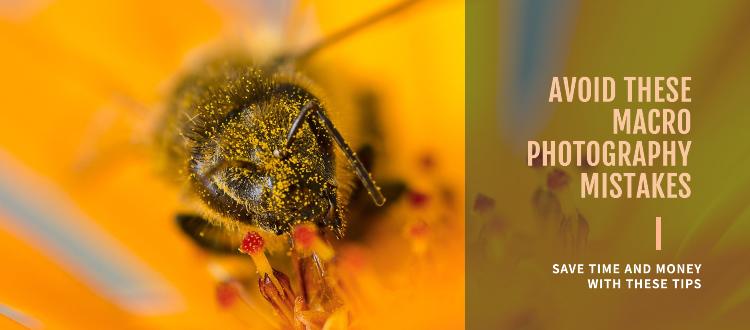Theodore Lowe, Ap #867-859
Sit Rd, Azusa New York
Find us here
6 Macro Photography Mistakes That Are Costing You Time And Money

Macro photography captures intricate details of small subjects, offering a unique perspective on the world. Yet, achieving stunning macro shots can be challenging, especially for beginners. Common mistakes, such as poor lighting, incorrect focus, and inappropriate equipment, often lead to frustration and wasted resources.
Understanding these pitfalls is crucial for improving your craft. This guide will help you identify and correct five frequent macro photography mistakes. By addressing these issues, you can enhance your photos and make better use of your time and money. Let's dive into the essentials for perfecting your macro photography skills.
1. Choosing The Wrong Lens
Choosing the wrong lens can ruin your macro photos. Lenses are crucial for capturing sharp, detailed images. The right lens saves time and money. A poor lens choice leads to blurry or distorted photos.
Common Lens Mistakes
Many photographers make common mistakes when selecting lenses for macro photography. These errors can waste time and money.
-
Using a standard lens: Standard lenses lack the magnification needed for macro shots.
-
Ignoring focal length: A lens with the wrong focal length can miss the subject.
-
Overlooking aperture: A small aperture can result in poor light and blurry images.
Best Lenses For Macro Photography
The right lens makes all the difference in macro photography. Here are some of the best choices:
|
Lens |
Focal Length |
Key Features |
|---|---|---|
|
Canon EF 100mm f/2.8L |
100mm |
Excellent sharpness, Image stabilization |
|
Nikon AF-S VR Micro-NIKKOR 105mm f/2.8G |
105mm |
Vibration reduction, High resolution |
|
Sony FE 90mm f/2.8 Macro G OSS |
90mm |
Optical SteadyShot, Great bokeh |
2. Ignoring Lighting
Ignoring lighting in macro photography can ruin your photos. Proper lighting is crucial for capturing stunning macro images. Without it, your photos may appear dull and lack detail.
Effects Of Poor Lighting
Poor lighting can lead to several issues in macro photography:
-
Blurry images: Low light makes it hard to capture sharp images.
-
Loss of detail: Shadows can hide important details in your subject.
-
Incorrect colors: Improper lighting can alter the true colors of your subject.
-
Increased noise: Low light forces higher ISO settings, resulting in grainy images.
Tips For Perfect Lighting
Follow these tips to improve your macro photography lighting:
-
Use natural light: Shoot during the golden hour for soft, even light.
-
Invest in a ring light: It provides consistent lighting around your subject.
-
Use reflectors: Bounce light to fill in shadows and enhance details.
-
Avoid direct flash: Use diffusers to soften the light from your flash.
-
Experiment with angles: Change the light angle to find the best look.
By focusing on proper lighting, your macro photos will improve dramatically. You will save time editing and avoid costly mistakes.
3. Poor Focus Techniques
Poor focus techniques can ruin macro photography. It wastes your time and money. Learning the proper focus method is crucial. Let's explore the common mistakes.
Manual Vs. Autofocus
Choosing between manual and autofocus is important. Autofocus is fast but not always accurate. Manual focus gives more control. Use manual focus for tiny subjects. Autofocus can struggle with small details. Knowing when to switch is key.
Achieving Sharp Focus
Achieving sharp focus is essential for macro photography. Start by stabilizing your camera. Use a tripod to avoid shakes. Adjust your focus ring slowly. Check your focus using the camera's live view. Magnify the image on the screen. This helps to see fine details.
Use focus stacking for deep focus. Take multiple photos at different focus points. Merge them in post-processing. This technique ensures every part is sharp.
Avoid focusing too quickly. Patience is necessary for clear shots. Practice regularly to improve your skills.
|
Technique |
Benefit |
|---|---|
|
Manual Focus |
More control over details |
|
Autofocus |
Faster but less accurate |
|
Focus Stacking |
Ensures deep focus |
-
Stabilize your camera with a tripod.
-
Adjust focus ring slowly and carefully.
-
Use live view to check focus.
-
Practice regularly to improve.
4. Neglecting Depth Of Field
Macro photography demands attention to detail. Neglecting depth of field can ruin your photos. Many beginners make this mistake. They focus too much on the subject. They forget about the background. This can cost you time and money. Let's explore why depth of field is crucial.
Importance Of Depth Of Field
The depth of field determines which parts of your photo are in focus. In macro photography, this is vital. A shallow depth of field can make your subject stand out. But it can also blur important details. A deep depth of field can capture more detail. But it can also make your photo look flat. Balancing depth of field is key.
Adjusting Aperture Settings
Your camera's aperture settings control the depth of field. A wide aperture (small f-number) creates a shallow depth of field. This is great for isolating your subject. A narrow aperture (large f-number) creates a deep depth of field. This captures more detail. Adjusting aperture settings can be tricky. Here’s a quick guide:
|
Aperture Setting |
Depth of Field |
Usage |
|---|---|---|
|
f/2.8 |
Shallow |
Isolate subject |
|
f/8 |
Moderate |
Balance detail |
|
f/16 |
Deep |
Maximize detail |
Experiment with different settings. Find what works best for you. Remember these tips:
-
Use a tripod to avoid camera shake.
-
Check your focus carefully.
-
Review your photos on a large screen.
Understanding and adjusting depth of field can improve your macro photography. It saves you time and money. Happy shooting!
5. Overlooking Backgrounds
Overlooking backgrounds is a common mistake in macro photography. A background can either make or break your shot. Focusing only on the subject can result in distracting backgrounds. This can ruin the beauty of your macro photograph. Paying attention to the background is crucial. It helps in creating a balanced and captivating image.
Common Background Issues
Several background issues can arise in macro photography. These problems can affect the quality of your shots. Here are some common background issues:
-
Cluttered Backgrounds: Too many elements can distract the viewer.
-
Too Bright or Dark: Incorrect lighting can ruin the shot.
-
Colors that Clash: Clashing colors divert attention from the subject.
-
Unwanted Objects: Unwanted items in the background can be distracting.
Creating Complementary Backgrounds
Creating a complementary background enhances the subject. It brings out the details and colors of your subject. Here’s how you can achieve this:
-
Use a Neutral Background: Neutral colors keep the focus on the subject.
-
Blur the Background: A shallow depth of field can make the subject stand out.
-
Choose Contrasting Colors: Contrast helps in highlighting the subject.
-
Remove Distractions: Clear the area of any distracting elements.
-
Use Textures: Background textures can add depth to the image.
Paying attention to the background can save you time and money. It ensures your macro shots are captivating and professional.
6. Lack Of Stability
Stability is crucial for macro photography. Even slight movements can ruin your shot. Without stability, your photos will be blurry. This can waste your time and money. Achieving stability requires proper tools and techniques.
Using Tripods And Stabilizers
A tripod is essential for stable shots. It reduces camera shake. Choose a sturdy tripod. Lightweight tripods can be unstable. Invest in a quality tripod for better results.
Stabilizers also help in maintaining stability. They are great for handheld shots. Use them to avoid blurry images. Stabilizers come in different types. Pick one that suits your needs.
|
Tool |
Purpose |
|---|---|
|
Tripod |
Reduces camera shake |
|
Stabilizer |
Improves handheld stability |
Minimizing Camera Shake
Camera shake is a common issue. It can ruin your macro shots. Use a remote shutter release. This prevents touching the camera. You can also use the camera's timer. Set it to a few seconds delay. This helps in reducing shake.
Ensure your camera is on a solid surface. Avoid shooting in windy conditions. Wind can cause vibrations. These vibrations can affect your shots. Use your body as support. Lean against a wall or tree. This adds extra stability.
-
Use a remote shutter release
-
Set the camera's timer
-
Shoot on solid surfaces
-
Avoid windy conditions
-
Use your body for extra stability
Conclusion
Avoiding common macro photography mistakes saves time and money. Focus on lighting, composition, and stabilization. Practice regularly to refine your skills. Stay patient and keep experimenting. Your photos will improve, showcasing stunning details. Mastering these tips ensures your macro photography journey is both rewarding and cost-effective.
Related blog posts
10 Best Ways to Share Photography With Your Clients
Capturing the perfect shot is only half the battle; sharing your stunning work with your clients is where the magic truly happens. As a photographer, you know how essential it is to deliver your photos in a way that wows and delights.


